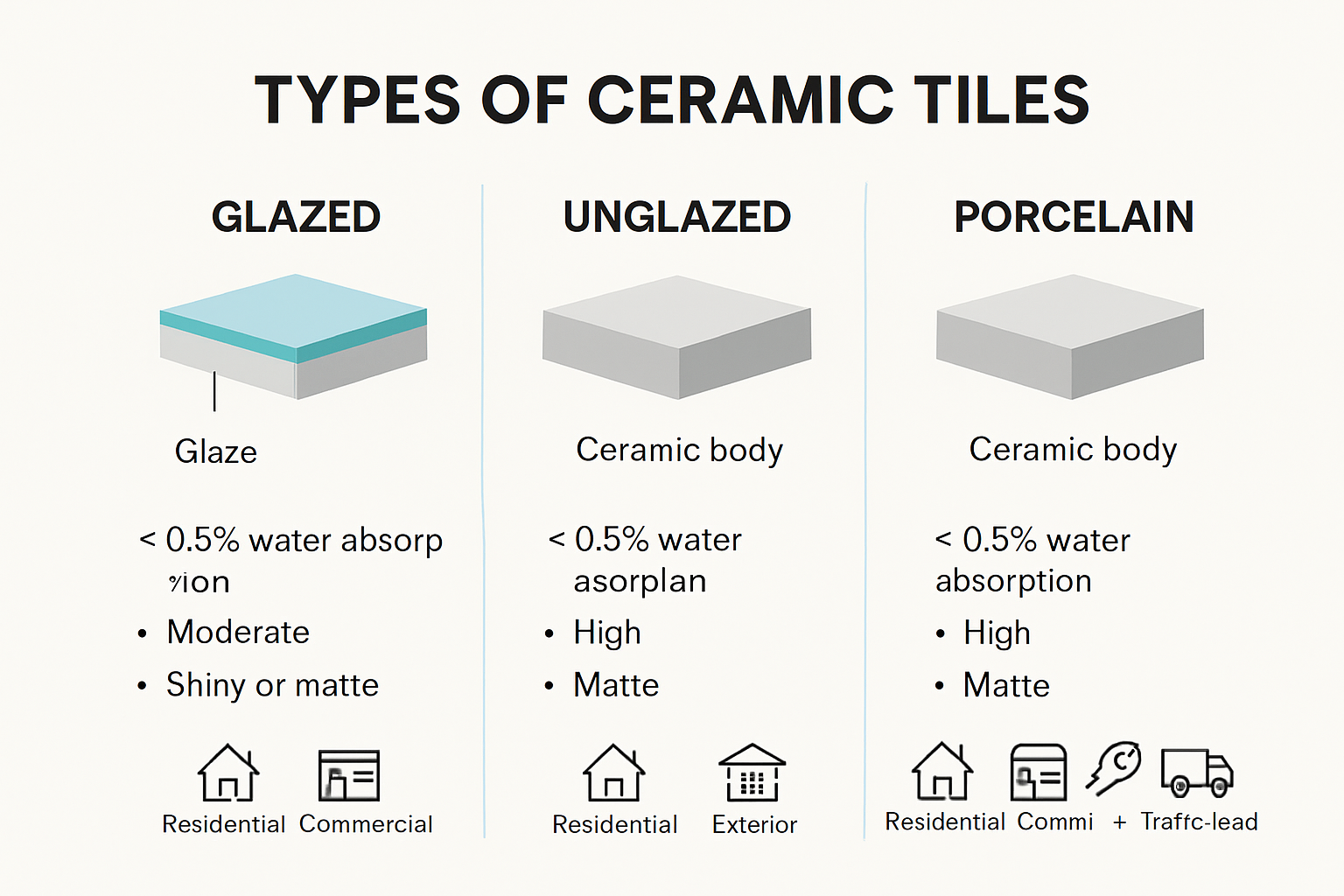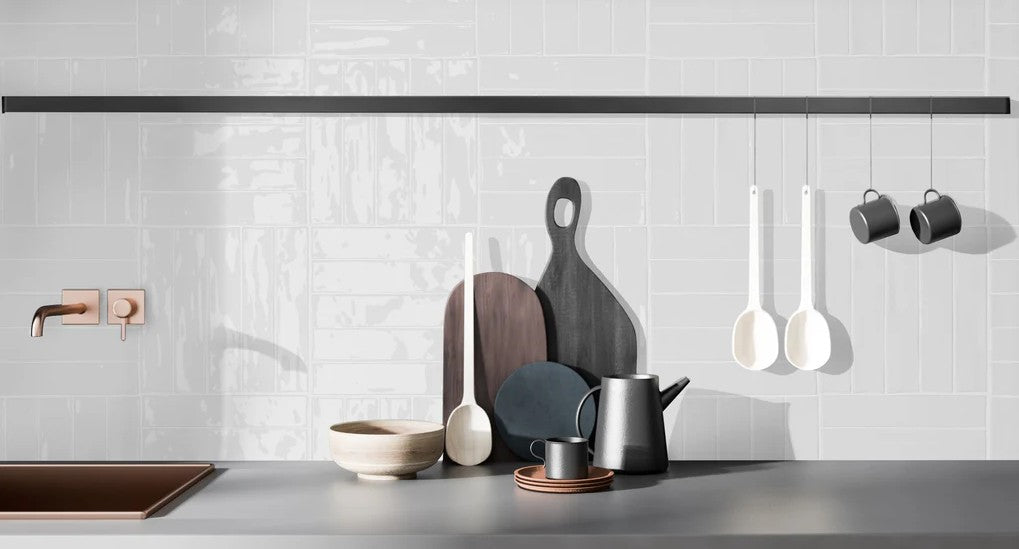Ceramic tiles are everywhere, covering floors and walls in homes and businesses all over the world. But most people have no idea that around 70 percent of residential tile installations use glazed ceramic tiles with a special protective coating. You might assume all tiles are basically the same, just colored differently, but that is completely off. The truth is, there are several basic types, and picking the wrong kind can turn your dream space into a maintenance headache.

Table of Contents
- What Are Ceramic Tiles And Their Basic Types?
- Why Choosing The Right Type Of Ceramic Tile Matters
- How Different Types Of Ceramic Tiles Are Made
- Key Characteristics Of Various Ceramic Tile Types
- Real-World Applications Of Types Of Ceramic Tiles
Quick Summary
| Takeaway | Explanation |
|---|---|
| Choose tiles based on application | Different environments require specific tile characteristics for optimal performance and longevity. |
| Understand tile composition for durability | Composition determines performance factors like wear resistance and slip resistance, impacting long-term usage. |
| Glazed tiles are ideal for aesthetics | The liquid glass coating enhances beauty and durability, making them perfect for low-traffic areas. |
| Porcelain tiles excel in demanding conditions | Higher firing temperatures create denser, less porous tiles, ideal for heavy foot traffic and outdoor use. |
| Unglazed tiles provide natural slip resistance | These tiles maintain a rustic aesthetic and are suitable for high-traffic areas requiring traction. |
What are Ceramic Tiles and Their Basic Types?
Ceramic tiles represent a versatile and popular flooring and wall covering solution used in residential and commercial spaces worldwide. These engineered materials are crafted from natural clay that undergoes precise manufacturing processes involving heating, molding, and glazing.
The Fundamental Composition of Ceramic Tiles
At their core, ceramic tiles are created from carefully selected clay materials that are transformed through high-temperature firing processes. The primary ingredients typically include:
- Natural clay minerals
- Sand
- Water
- Additional mineral compounds
During manufacturing, these raw materials are mixed, shaped into desired tile forms, and then fired in kilns at temperatures ranging between 1000 to 1250 degrees Fahrenheit. This intense heat causes chemical and physical transformations that result in durable, hardwearing surface materials.
Basic Categories of Ceramic Tiles
Ceramic tiles can be broadly categorized into several fundamental types based on their manufacturing technique and intended application:
Glazed Ceramic Tiles These tiles feature a liquid glass coating applied before the final firing process, creating a protective layer that offers decorative possibilities and enhanced surface durability. According to Tile Council of North America, glazed ceramic tiles represent approximately 70% of residential tile installations.
Unglazed Ceramic Tiles Unglazed tiles maintain their natural clay appearance and possess a more rustic, organic aesthetic. They are typically denser and provide excellent slip resistance, making them ideal for high-traffic areas and exterior applications.
Porcelain Ceramic Tiles A specialized subset of ceramic tiles, porcelain tiles are manufactured using more refined clay and are fired at higher temperatures. This process results in an exceptionally dense, less porous material suitable for demanding environments like commercial spaces and outdoor installations.
Understanding these basic types of ceramic tiles enables homeowners and designers to make informed decisions about surface materials that balance aesthetic preferences with functional requirements.
To help you quickly compare the three primary types of ceramic tiles discussed in this guide, the table below summarizes their defining features, durability, and ideal applications.
| Tile Type | Key Features | Durability and Resistance | Ideal Applications |
|---|---|---|---|
| Glazed Ceramic Tiles | Protective glass coating; decorative | Good surface durability; less resistant to heavy impact | Interior walls, decorative surfaces, low-traffic areas |
| Unglazed Ceramic Tiles | No glass coating; natural, rustic look | Higher slip resistance; denser, but more prone to staining | High-traffic areas, outdoor spaces, where slip resistance is needed |
| Porcelain Tiles | Made from refined clay; high temp fired | Exceptional density; lowest water absorption; very durable | High-traffic floors, exterior spaces, commercial areas |
Why Choosing the Right Type of Ceramic Tile Matters
Selecting the appropriate ceramic tile involves far more than aesthetic considerations. The right tile can significantly impact a space’s functionality, durability, maintenance requirements, and overall performance across different environments.
Performance and Durability Factors
Ceramic tiles are not universally interchangeable. Different areas of your home or commercial space demand specific tile characteristics. According to the World Floor Covering Association, tile selection directly influences long-term performance and maintenance needs.
Key performance considerations include:
- Wear resistance
- Moisture absorption rate
- Surface hardness
- Impact durability
- Slip resistance
Traffic and Usage Implications High-traffic areas like entryways, kitchens, and commercial spaces require tiles with superior durability. Porcelain tiles with higher Porcelain Enamel Institute (PEI) ratings provide enhanced resistance to scratching and wear. Learn more about choosing durable tile solutions.
For an at-a-glance reference, the following table outlines key performance factors for ceramic tiles and explains their impact on choosing the best tile type for different environments.
| Performance Factor | Description | Why It Matters |
|---|---|---|
| Wear Resistance | Ability to withstand foot traffic and abrasion | Ensures longevity in high-use areas |
| Moisture Absorption Rate | How quickly tile absorbs water | Important for wet or outdoor spaces |
| Surface Hardness | Resistance to scratching and denting | Impacts maintenance and lifespan |
| Impact Durability | Withstands drops or heavy impacts | Critical for floors and hallways |
| Slip Resistance | Degree to which tile prevents slipping | Key for safety in wet environments |
Environmental and Functional Considerations
Environmental conditions play a crucial role in tile selection. Exterior applications demand tiles with low water absorption rates and excellent freeze-thaw resistance. Indoor spaces like bathrooms and kitchens require tiles with superior moisture resistance and easy-to-clean surfaces.
Consider these critical environmental factors:
- Temperature fluctuations
- Moisture exposure
- Chemical resistance
- UV radiation levels
- Potential mechanical stress
By understanding these nuanced requirements, homeowners and designers can make informed decisions that ensure both aesthetic appeal and long-term functionality of their ceramic tile installations.
How Different Types of Ceramic Tiles Are Made
Ceramic tile manufacturing is a sophisticated process involving multiple precise stages that transform raw natural materials into durable surface coverings. Each type of ceramic tile requires specific techniques and treatments to achieve its unique characteristics and performance properties.
Raw Material Preparation and Composition
The initial stage of ceramic tile production involves carefully selecting and preparing raw materials. According to WikiBooks Manufacturing Guide, manufacturers meticulously blend natural clay, sand, feldspar, and other mineral compounds to create the foundational tile mixture.
Key ingredients typically include:
- Natural clay minerals
- Silica sand
- Feldspar
- Water
- Mineral additives
Forming and Shaping Techniques Manufacturers employ different forming methods depending on the desired tile type. Extrusion, pressing, and casting represent primary techniques used to shape ceramic tiles. Explore our advanced tile manufacturing techniques for deeper understanding.
Firing and Finishing Processes
The transformation of raw materials into ceramic tiles occurs through high-temperature firing processes. Kilns heat the tile materials to temperatures ranging between 1000 to 1250 degrees Fahrenheit, causing critical chemical and physical changes.
Different tile types undergo unique finishing treatments:
- Glazed tiles receive liquid glass coatings
- Porcelain tiles experience extended high-temperature firing
- Unglazed tiles maintain their natural mineral appearance
These manufacturing nuances determine each tile’s final strength, water resistance, and aesthetic properties, making the production process a precise blend of scientific engineering and artistic craftsmanship.
Key Characteristics of Various Ceramic Tile Types
Ceramic tiles are not a monolithic category but a diverse range of materials with unique characteristics tailored to specific applications. Understanding these distinctions helps homeowners and designers make informed decisions about surface treatments.
Performance and Structural Variations
Each ceramic tile type presents distinct performance attributes that determine its suitability for different environments. According to ceramic engineering research, these variations stem from manufacturing techniques, raw material composition, and firing processes.
Key performance indicators include:
- Compressive strength
- Water absorption rate
- Surface hardness
- Thermal shock resistance
- Wear resistance
Comparative Tile Characteristics Glazing and manufacturing processes significantly influence tile performance. Porcelain tiles, for instance, demonstrate superior durability compared to standard ceramic tiles due to their denser composition and higher firing temperatures. Explore detailed tile performance specifications.
Application-Specific Tile Characteristics
Tile selection requires careful consideration of environmental conditions and functional requirements. Different ceramic tile types excel in specific scenarios:
- Glazed Ceramic Tiles: Ideal for interior walls, decorative surfaces, and low-traffic areas
- Porcelain Tiles: Recommended for high-traffic floors, exterior applications, and commercial spaces
- Unglazed Ceramic Tiles: Best suited for areas requiring natural slip resistance and rustic aesthetics

By understanding these nuanced characteristics, professionals can select ceramic tiles that not only look appealing but also perform optimally in their intended environment.
Real-World Applications of Types of Ceramic Tiles
Ceramic tiles transcend mere decorative elements, serving critical functional roles across residential, commercial, and industrial environments. Their versatility and performance characteristics make them indispensable in numerous architectural and design applications.
Interior Design and Architectural Applications
According to the American Ceramic Society, ceramic tiles play a transformative role in interior spaces. They offer designers and homeowners remarkable flexibility in creating visually stunning and highly functional environments.
Key interior application areas include:
- Kitchen backsplashes
- Bathroom wall and floor coverings
- Fireplace surrounds
- Decorative accent walls
- Interior flooring solutions
Specialized Design Considerations Different ceramic tile types serve specific design objectives. Glazed tiles provide vibrant color options and smooth surfaces, while textured unglazed tiles offer natural, rustic aesthetics. Explore innovative tile design possibilities for your next project.
Exterior and High-Performance Applications
Ceramic tiles extend far beyond interior spaces, demonstrating exceptional performance in challenging outdoor environments. Porcelain tiles, with their dense composition and low water absorption rates, excel in exterior applications.
Critical exterior usage scenarios include:
- Patio and terrace flooring
- Pool deck surfacing
- Outdoor kitchen areas
- Landscaping design elements
- Commercial building facades
By understanding the unique characteristics of different ceramic tile types, professionals can select materials that not only meet aesthetic preferences but also withstand complex environmental challenges, ensuring long-lasting performance and visual appeal.

Find the Perfect Ceramic Tile Type for Your Home or Business—Effortlessly
Feeling unsure about which ceramic tile will truly stand up to daily use, match your design vision, and stay beautiful for years? You are not alone. Many people worry about choosing tiles that are either too delicate for high-traffic areas or too plain for bold interiors. The article above highlights important features like wear resistance, slip resistance, and moisture protection. But how do you transform that knowledge into the right choice for your actual space?

Solve your flooring and wall tile challenges today when you visit TileChoices.com. Explore our curated selections, detailed product insights, and design inspiration to match every room and every need. Experience the confidence of knowing every tile option is covered with reliable info and real value. Ready for your project to move from confusion to clarity? Head to our main site and start building your dream space now.
Frequently Asked Questions
What are the main types of ceramic tiles?
Ceramic tiles are primarily categorized into glazed ceramic tiles, unglazed ceramic tiles, and porcelain ceramic tiles. Each type has distinct characteristics suited for various applications.
How do porcelain tiles differ from glazed ceramic tiles?
Porcelain tiles are denser and less porous due to being made from more refined clay and fired at higher temperatures, making them ideal for high-traffic and outdoor applications. Glazed ceramic tiles, on the other hand, have a protective glass coating and are more suitable for decorative surfaces and low-traffic areas.
What factors should I consider when choosing ceramic tiles for a high-traffic area?
When selecting tiles for high-traffic areas, consider wear resistance, slip resistance, and surface hardness. Porcelain tiles generally provide better durability under heavy use compared to standard ceramic tiles.
Are unglazed ceramic tiles suitable for outdoor installations?
Yes, unglazed ceramic tiles offer excellent slip resistance and a rustic aesthetic, making them suitable for outdoor applications. However, ensure they have low water absorption rates for better freeze-thaw resistance.









